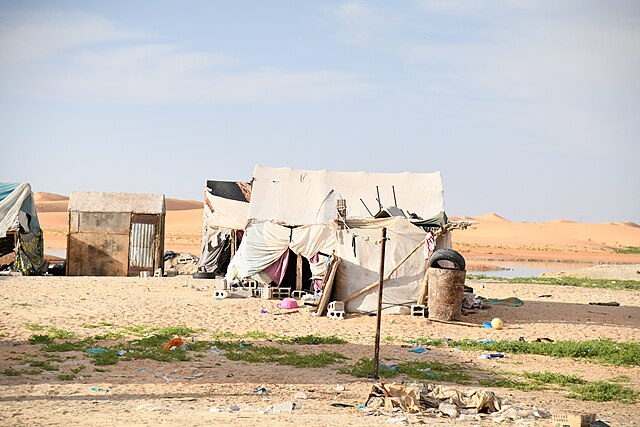 Agricultural workers shelter in Mauritania. Picture by Francesca Calisti.
Agricultural workers shelter in Mauritania. Picture by Francesca Calisti.
How Climate Change Fuels Conflict in the Sahel
The House Foreign Affairs Subcommittee on Africa recently convened a hearing titled “The Sahel in Crisis”. In addition to coups and humanitarian disasters, multiple panelists mentioned climate change as a contributor to rising violence. While it may not be as direct as the risk posed by destabilization or terrorism, the ongoing crisis in the Sahel is deeply coupled with changing weather and atmospheric conditions. Understanding the downstream effects of climate change in the context of the Sahel demonstrates the role these shifts play in destabilization and conflict globally.
The Sahel is geographically positioned to face major changes in temperature and precipitation as a result of climate change. Global Climate Models (GCMs) predict background average temperatures will rise 2.0 to 4.3 degrees Celsius by 2080. The number of extreme heat days (days of 35 degrees Celsius or higher that threaten human health) is also expected to rise by up to 125 days per year. According to GCMs run by Lawrence Livermore National Lab and the United Nations, these temperature predictions are within a small certainty range. However, GCMs disagree on expected precipitation changes. Even models within the central 90% of projections differ by up to 50mm/year in estimates of future changes in precipitation. Recent research shows that by 2040, desert countries like Mali and Niger could experience the amount of rainfall we currently see in tropically vegetated countries like Nigeria. Yet, GCMs that project increasing rainfall show average increases as driven by a small number of extreme precipitation events rather than regular rainfall, which can lead to devastating flooding.
Adapting to the magnitude of temperature and precipitation changes expected in the Sahel will be challenging for already stressed governments. The agri-food industry accounts for seventy-five percent of employment in the region, making it the basis of the economy. Climate change destabilizes agriculture, altering which crops can succeed. Increasing temperature can decrease maize, millet, and sorghum yields, all of which are staple crops in the Sahel. Other crops, like cassava and cowpeas, may see increased yields due to increased atmospheric carbon dioxide levels. Regardless of crop type, it is nearly impossible to maintain large-scale production using traditional techniques under highly variable rainfall conditions. Localities with increasing rainfall will face flooding, while other areas could see the drought exposure of cropland double from 2000 to 2080. This will make annual crop yields unpredictable, decreasing food supply and leading to a rise in food costs. The decreased profitability of the agri-food industry then leads to fewer employment opportunities. The combination of these changes increases resource scarcity and competition, posing a major threat to economic security.
This economic security threat is exacerbated by recent population growth. Population in the Sahel has experienced an almost five-fold increase over the last sixty years. This growth comes from a variety of factors, including a high birth rate and declining infant mortality rate, worsened by densely populated cities with low rates of education. In Burkina Faso, Chad, Mali, Mauritania, and Niger, the number of people facing starvation jumped from 3.6 million in 2019 to 10.5 million in 2022. As a result of population growth, lack of economic opportunity, and food insecurity, the Sahel has become the epicenter of a forced displacement crisis. In 2021, two million people were internally displaced, with disproportionately women and children losing access to health services, food, water, and education.
Climate-driven crises leave residents vulnerable to exploitation and recruitment by extremist groups. Agriculturists unable to farm are more likely to join extremist organizations in exchange for food and shelter. For example, Boko Haram targets areas for recruitment immediately after periods of flooding and/or poor crop yields. In part due to climate-related terrorist recruitment, climate change was named a major threat exacerbator by U.S. Africa Command. As climate change leads to further destabilization, the Sahel has seen increased recruitment by extremist groups. In 2022, forty-three percent of global terrorism deaths occurred in the Sahel at the hands of groups including al-Qaeda in the Islamic Maghreb, Jama’at Nusrat al-Islam wal-Muslimin, the Islamic State in the Greater Sahara, and Boko Haram.
Climate change and violent extremism may seem to be separate policy considerations, but climate change’s destabilization effects on local populations facilitate the spread of violent extremism. Temperature and precipitation changes pose a threat to economic stability, exacerbate food insecurity, and lead to displacement in search of resources. This humanitarian crisis then leaves populations vulnerable to terrorist recruitment, especially in the wake of increased flooding, drought, and other disasters. The Sahel is a model for other regions soon to be affected by climate change, and understanding these compounding climate impacts is vital to preventing regional destabilization and conflict globally.





